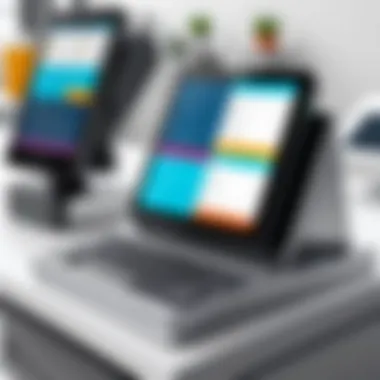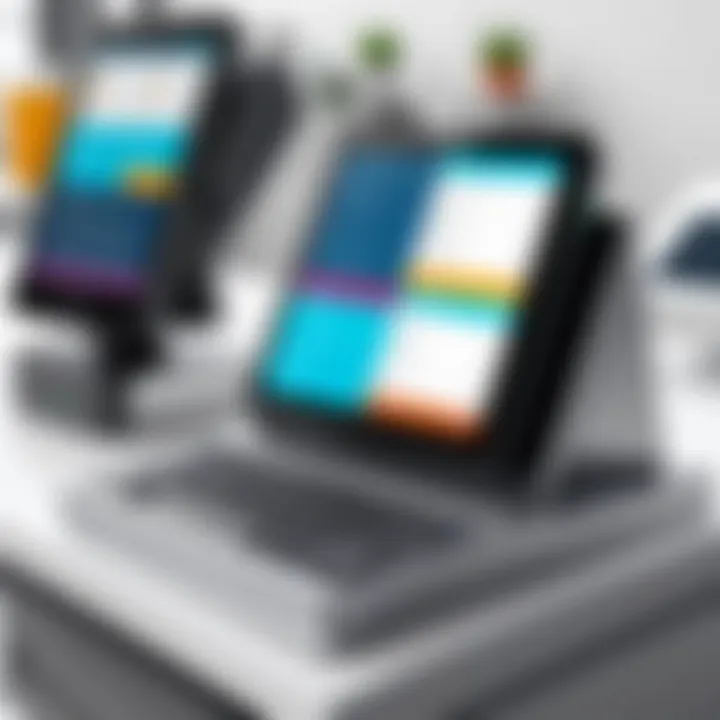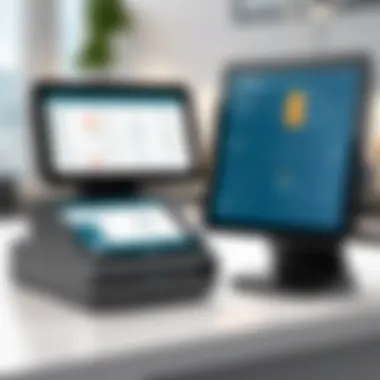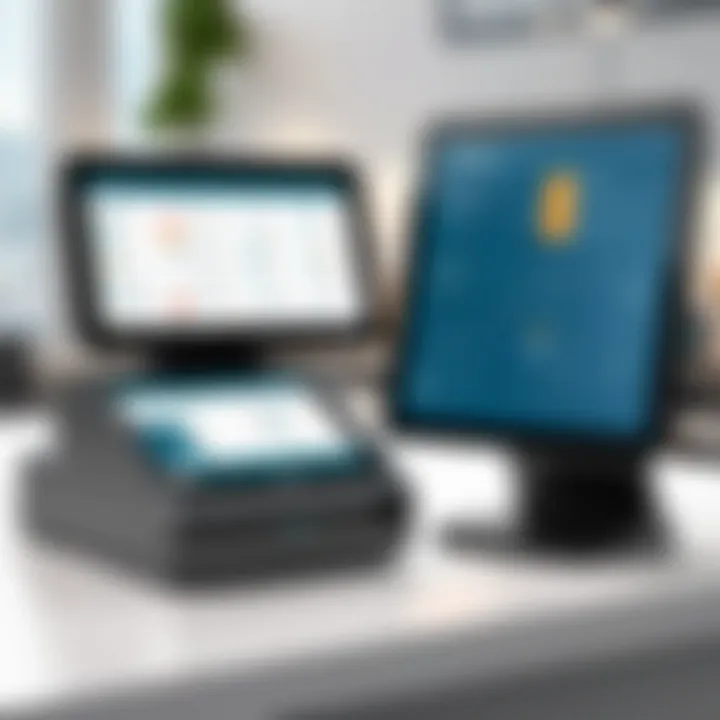Understanding POS Software: A Complete Guide


Intro
In the modern retail and service landscape, Point of Sale (POS) systems play a crucial role in facilitating transactions and managing business operations. Understanding POS software means recognizing its significance in not only processing sales but also enhancing operational efficiency. This section aims to provide a foundational insight into what POS software is and why it is an indispensable tool for businesses today.
Software Overview
Brief Description of Software
POS software serves as the backbone of sales operations in various sectors like retail, hospitality, and service industries. It enables businesses to perform multiple functions including processing payments, managing inventory, and generating sales reports. With the rise of digital payments, POS systems have evolved to support various payment methods, such as credit cards, mobile wallets, and even cryptocurrencies.
Key Features and Functionalities
The features of POS software vary across different platforms; however, some core functionalities remain consistent:
- Sales Transactions: Quick and reliable processing of sales through a user-friendly interface.
- Inventory Management: Real-time tracking of stock levels, automatic updates after sales, and alerts for low inventories.
- Customer Relationship Management (CRM): Tools to manage customer data, preferences, and purchase histories to enhance customer loyalty.
- Reporting and Analytics: Comprehensive sales reporting options that allow businesses to analyze trends and make informed decisions.
- Employee Management: Features that help in tracking employee performance and attendance.
Detailed Comparison
Comparison with Competitors
When evaluating POS software, it is insightful to compare its offerings with competitors. Names like Square, Shopify POS, and Toast POS each have their unique strengths and weaknesses. Each system's scalability, ease of use, and customer support can heavily influence the choice for businesses.
For example, Square is known for its user-friendly interface and transparent pricing, making it a favorite among small businesses. Meanwhile, Toast POS specializes in the hospitality sector, offering advanced features tailored specifically for restaurants.
Pricing Structure
Understanding the pricing structure is essential for decision-makers. Prices for POS software can range widely, influenced by the features provided, the scale of business, and whether it is cloud-based or on-premise. Generally, pricing models can include:
- Monthly Subscription: Regular fees that provide access to the software and support.
- One-time Purchase: A larger upfront cost for ownership of the software.
- Transaction Fees: Additional costs incurred based on sales volume for payment processing.
Laaying a transparent pricing model is a significant factor when selecting the appropriate software. Businesses should analyze their expected transaction volumes and compare associated fees to select the most cost-effective solution.
Understanding the nuances of POS systems can provide a competitive edge. An informed decision not only facilitates operational efficiency but also enhances customer experience.
Prelims to POS Software
The realm of point of sale (POS) software represents a critical intersection between technology and commerce. Understanding this topic not only involves comprehending the basic functionalities of POS systems, but also appreciating their transformative impact on businesses across various industries. A well-implemented POS system can streamline operations, enhance customer experiences, and provide valuable insights through analytics. In an era where transactions happen at lightning speed and data drives decision-making, a profound grasp of POS software can dictate a company's competitive edge.
Definition of POS Software
Point of sale software refers to the digital systems that facilitate retail transactions. This includes the hardware and software that allow businesses to process sales, manage inventory, and analyze customer behavior. At its core, POS software transforms the traditional cash register into a multi-functional business tool. The typical features of POS software include payment processing, inventory management, customer relationship management, and real-time reporting. These capabilities help businesses not just to process purchases, but also to understand their operations better, adapt to market changes, and enhance overall efficiency.
Historical Background
The evolution of POS software traces back to the early 20th century. Originally, cash registers were mechanical devices that recorded sales; over time, technology advanced, leading to the introduction of electronic cash registers in the 1970s. The true turning point came in the 1980s with the advent of computer-based systems, which drastically improved transaction speed and accuracy. As businesses started to embrace database technology, POS systems began to integrate more robust features, including inventory tracking and sales reporting. Today, with the rise of cloud computing and mobile technology, POS software continues to evolve, offering businesses flexibility and sophistication in managing their operations.
As of now, POS systems are not merely transaction tools; they are comprehensive platforms that drive business growth and customer satisfaction.
Core Components of POS Software
The core components of POS software are vital in understanding its function and significance within various business environments. Each element plays a distinct role that contributes to the software's overall effectiveness. A well-structured POS system can streamline operations, enhance customer experience, and provide valuable insights into business performance. Therefore, evaluating these core components is crucial for businesses looking to implement or upgrade their POS systems.
User Interface
The user interface (UI) is the first point of contact for users. It dictates how easily employees can navigate and operate the system. A user-friendly UI minimizes training time and errors. Companies must prioritize intuitive design to ensure that staff can efficiently handle transactions and manage operations. Elements such as button layout, color schemes, and ease of access to functions are important. A clean interface reduces confusion and speeds up service, which is beneficial during peak business hours.
Payment Processing
Payment processing is at the heart of any POS system. This component manages various payment methods, including credit cards, debit cards, mobile payments, and cash transactions. Robust payment processing capabilities ensure transactions are secure and quick. Features such as contactless payments and integration with third-party payment platforms are valuable. The reliability of this component directly affects customer satisfaction and trust. Businesses must select POS systems that comply with industry standards for security, such as PCI DSS, to protect sensitive payment information.
Inventory Management
Inventory management is essential for businesses that maintain stock. This core component monitors inventory levels, tracks sales trends, and manages orders. Effective inventory management helps prevent stockouts and overstock situations, optimizing storage costs. Features like real-time tracking, automated alerts for low stock, and sales forecasting tools play a significant role here. By accurately managing inventory, businesses can enhance efficiency, reduce waste, and respond quickly to market demand.
Reporting and Analytics
Reporting and analytics features provide insights into business performance. Comprehensive data analysis allows decision-makers to identify trends, assess operational efficiency, and develop strategies for improvement. Metrics such as sales figures, customer preferences, and inventory turnover are crucial. A POS system that offers advanced reporting capabilities facilitates better business decisions. This information is invaluable for optimizing marketing strategies and operational workflows, ultimately leading to measurable growth.
"Effective POS systems are not just about processing sales; they're essential tools for business intelligence."
In summary, the core components of POS software interact to create a coherent system that enhances business operations. A focus on user interface, payment processing, inventory management, and reporting ensures that businesses can efficiently manage their sales and gain strategic insights. Thus, when selecting a POS system, it is crucial to assess these components to meet the specific needs of the organization.
Types of POS Software
Understanding the various types of POS software is crucial for making informed business decisions. Each type caters to different operational needs and customer demographics. Choosing the right system can greatly influence efficiency, accuracy, and customer satisfaction. Below, we explore three primary categories: Cloud-Based, On-Premise, and Mobile POS solutions.
Cloud-Based POS Systems


Cloud-based POS systems have gained popularity due to their flexibility and ease of access. These systems operate over the internet, allowing for real-time data updates from any location. One of the key benefits is the lower upfront cost. Businesses do not need to invest heavily in hardware, as much of the processing occurs on remote servers.
Key features of cloud-based systems include automatic updates and data backup, reducing the burden on IT personnel. Accessibility also extends to remote monitoring, where owners can check sales and inventory remotely. A consideration for businesses is the dependency on a stable internet connection. Any disruption can lead to delays or loss of service, which may impact transaction processing.
On-Premise POS Systems
On-premise POS systems store data locally on physical servers. These systems are preferred by businesses that require complete control over their data and operations. Security can be a significant concern, especially in industries that handle sensitive customer information. By keeping data in-house, businesses can implement stringent security measures tailored to their specific needs.
Another advantage is the customization potential. On-premise systems can be tailored to fit the unique operational requirements of a business. However, this setup often comes with higher initial costs for hardware and software, along with ongoing maintenance expenses. Additionally, businesses must consider the need for in-house IT support to manage the system effectively.
Mobile POS Solutions
Mobile POS solutions have revolutionized how transactions are processed. They utilize portable devices like tablets and smartphones to enable business operations outside a traditional checkout environment. This flexibility appeals especially to industries such as retail and hospitality. Mobile systems can enhance customer interaction by allowing staff to check out customers anywhere in the store or restaurant.
The adoption of mobile systems often leads to improved customer experiences, as they reduce wait times. Furthermore, mobile solutions frequently integrate with cloud-based systems, enabling easy data access and real-time sales tracking. Nonetheless, businesses should ensure that their mobile devices are equipped with secure payment processing features to mitigate risks associated with mobile transactions.
“Choosing the right type of POS software can greatly streamline operations and improve customer satisfaction.”
Benefits of Implementing POS Software
Implementing POS software plays a critical role in the contemporary business landscape. As firms strive to optimize operations and enhance customer satisfaction, the benefits of utilizing POS systems become increasingly evident. This section delves into the specific advantages that POS software offers to various types of businesses, illuminating how it can make a significant impact on overall effectiveness.
Operational Efficiency
One of the foremost benefits of POS software is operational efficiency. By automating various tasks, business owners can save time and reduce human error. For example, tasks such as sales tracking, inventory management, and employee scheduling can be streamlined with POS systems. This automation is particularly crucial during peak seasons when manual processes can become bottlenecks.
- Real-time inventory updates: POS software ensures that inventory levels are updated in real time. This means that once a sale occurs, stock levels reflect the current state, helping to avoid overselling or stockouts.
- Faster transaction processing: With integrated payment systems, transactions can be completed more swiftly, which reduces waiting times for customers and enhances the overall shopping experience.
- Task management: Many POS systems include features for staff management, allowing for more efficient scheduling and task assignments, thus optimizing workforce productivity.
Efficient operations can consequently lead to reduced operational costs and improved profitability.
Improved Customer Experience
Another significant benefit is the enhancement of customer experience. POS systems are designed not only to manage sales but also to provide insights and features that cater to customer needs. A seamless transaction process is crucial for customer satisfaction, and POS software facilitates this in various ways.
- Personalized service: With access to customer purchase history, employees can provide tailored recommendations and special offers to returning customers.
- Loyalty programs: Many POS systems incorporate loyalty programs that allow businesses to reward repeat customers, fostering customer retention and encouraging repeated visits.
- Multiple payment options: Customers prefer flexibility in payment methods, and POS systems usually support various options such as debit, credit, and mobile payments, making transactions convenient.
Ultimately, a profound customer experience leads to increased customer loyalty and positive word of mouth.
Accurate Financial Tracking
Accurate financial tracking is critical for any business, and POS software excels in this area. By providing real-time data insights and analytics, POS systems enable businesses to monitor their financial health effectively.
- Detailed sales reports: Businesses can generate reports that detail daily, weekly, or monthly sales, enabling better forecasting and planning.
- Cost management: Accurate tracking of sales also aids in cost management. Businesses can analyze which products are performing well and which are not, allowing for informed decisions on pricing and inventory.
- Tax compliance: POS software can simplify tax reporting by maintaining organized transaction records, which is essential for meeting tax obligations accurately.
Maintaining precise financial records leads to better financial decision-making, ultimately allowing companies to reach their growth goals.
Implementing a robust POS system is more than a trend; it is a strategic necessity in today's competitive market, allowing businesses to streamline operations, enhance customer engagement, and track their financials with accuracy.
Key Features to Look For
When considering a Point of Sale (POS) software solution, several critical features significantly influence its effectiveness and suitability for a business. The right features not only enable operational efficiency but also enhance the overall user experience. Understanding these features will guide decision-makers toward a POS system that meets their business needs.
User-Friendly Design
A user-friendly design is fundamental when choosing POS software. If the interface is intuitive, employees can learn the system quickly, which minimizes training time and enhances productivity. A complex interface might lead to frustration and errors during transactions. The layout should allow users to navigate easily and access essential functions swiftly. Features such as touchscreen compatibility can add to the user experience. Moreover, a consistent and organized visual hierarchy helps users find what they need without confusion. Simplified workflows further contribute to a more efficient transaction process.
Scalability
Scalability refers to the ability of the POS software to grow alongside the business. This is crucial for companies that anticipate expansion. A scalable system can accommodate increasing transaction volumes, additional features, and new locations without requiring a complete overhaul. Businesses should look for solutions that allow easy addition of functionalities, such as loyalty programs or advanced reporting tools. Being able to upgrade easily ensures that the investment in software remains viable over time.
Integration Capabilities
Integration capabilities are essential in today's interconnected business environment. The POS system should seamlessly connect with other business tools such as Customer Relationship Management (CRM) systems, e-commerce platforms, and accounting software. This integration enables data to flow freely between systems, reducing manual entry and the potential for errors. Moreover, businesses benefit from having a unified view of their operations, allowing better strategic decisions. When evaluating POS software, check for API availability and compatible third-party applications. This can greatly enhance operational efficiency and data accuracy.
"Choosing the right features in a POS system can significantly influence a business's success by streamlining operations and improving decision-making processes."
In summary, focusing on user-friendly design, scalability, and integration capabilities is essential when selecting POS software. These key features support a business's efficiency, adaptability, and overall effectiveness in managing sales processes.
Challenges in POS Software Implementation
Implementing POS software presents several challenges that can impact a business's operations and efficiency. Understanding these issues is essential for decision-makers and IT professionals, as it directly affects how effectively a business adapts to new technology.
Software Compatibility
Software compatibility is a significant concern in the adoption of POS systems. Businesses often employ various software solutions that manage different aspects of their operations. Integrating a new POS system with existing software can be complex. Failure to ensure compatibility can lead to data silos, where information within the business does not flow seamlessly. This can hinder decision-making.
Additionally, some older systems may not support modern POS features. This might require businesses to overhaul their entire software infrastructure, leading to increased costs and downtime. Compatibility should be evaluated during the decision-making process to avoid disruptions in service.


Training and Adoption
Training is another critical aspect of POS implementation. Staff members must be adequately trained to use the new system effectively. Without proper training, employees may struggle to adapt, leading to inefficiencies and errors in operations. This can negatively affect customer service and overall productivity.
It's also important to consider the cultural shift that might be needed within a business. Employees can be resistant to change. Therefore, clear communication about the benefits of the new system and continuous support can help alleviate fears and promote faster adoption. Consider implementing a phased approach to training, allowing employees to acclimate gradually to the new system.
Cost Considerations
Cost considerations can often be a dealbreaker in POS software implementation. Businesses need to evaluate not just the initial costs of the software, but also any hidden costs associated with implementation. This includes potential costs for hardware, training, and ongoing technical support.
It's also wise to consider the long-term return on investment. Although some POS systems might seem expensive upfront, they can lead to savings over time through improved efficiency, better inventory management, and enhanced customer experience. Businesses should weigh the immediate costs against the expected benefits to make a well-informed decision.
"Investing in the right POS software is crucial; understanding all implementation challenges ensures better preparedness and operational success.”
Integration with Other Software Systems
The ability for POS software to integrate with other software systems is crucial for creating a seamless operational environment. Businesses today rely on various tools ranging from customer relationship management (CRM) systems to e-commerce platforms and accounting software. Each of these systems serves different purposes but can significantly enhance the capabilities of POS systems when integrated effectively.
Integrating POS software with other systems eliminates the need for manual data entry, thus reducing errors and saving time. Furthermore, comprehensive integration can lead to better customer insights, improved sales forecasting, and overall enhanced customer experiences. Effective integration also allows for centralized data management, which is vital for decision-making processes.
CRM Integration
Integrating POS software with CRM systems is one of the most significant advancements in the retail and service landscapes. A CRM system manages customer interactions and data throughout the customer lifecycle. When these systems interact, businesses can access detailed customer insights that help tailor marketing strategies and improve customer service.
With POS and CRM integration:
- Customer Data: Businesses can capture customer data directly at the point of sale, including purchase history and preferences.
- Personalization: Personalized marketing campaigns can be developed based on customer behavior, increasing customer loyalty and satisfaction.
- Sales Tracking: Enhanced tracking of customer purchases simplifies loyalty programs and reward systems.
The result is a more informed sales approach and better customer relationships.
E-commerce Platforms
In today’s digital economy, merging POS systems with e-commerce platforms is essential for retailers who operate both physical and online stores. Integration facilitates a streamlined view of inventory, orders, and customer data.
Benefits of this integration include:
- Unified Inventory Management: Real-time inventory updates across channels help to prevent stockouts or overselling products.
- Data Synchronization: Integrating sales data helps to understand purchasing patterns both in-store and online.
- Expanded Reach: It allows businesses to leverage online sales, thus expanding market reach beyond physical locations.
This integration further empowers businesses to implement omnichannel strategies effectively, offering customers a consistent experience.
Accounting Software
Accounting software integration with POS systems simplifies financial processes significantly. Accurate financial management is crucial for any business, and this integration ensures that sales data seamlessly transfer to accounting platforms.
This integration provides the following advantages:
- Automated Reporting: It reduces the time spent generating reports by automatically updating financial records.
- Real-Time Data: Businesses gain immediate insights into their financial status, enhancing decision-making.
- Error Reduction: Automatic data transfer minimizes the risk of errors compared to manual entries.
Incorporating accounting features directly within the POS system further enhances efficiency, from tax calculations to detailed sales reports.
"Integrating POS software with other systems creates an ecosystem that enhances business capabilities and efficiency."
Industry-Specific Applications
Understanding the nuances of Point of Sale (POS) software across different industries is essential. Each sector has distinct requirements and challenges, leading to tailored applications designed to enhance efficiency and streamline operations. The functionality of POS systems varies based on industry, offering specialized features that cater specifically to the operational needs of each business type. This section highlights how POS software plays a crucial role in retail, hospitality, and healthcare environments.
Retail
In the retail sector, POS software is integral to daily operations. It facilitates not only sales tracking but also inventory management and customer relationship management. Retail POS systems enhance the shopping experience through features like barcode scanning, mobile payments, and loyalty programs.
Key Benefits:
- Inventory Tracking: Retail POS systems provide real-time inventory updates. This allows for better stock management, reducing overstock and stockouts.
- Sales Analysis: The software analyzes sales data, enabling retailers to make informed decisions about promotions and product positioning.
- Customer Insights: POS systems can collect customer data, helping retailers tailor marketing efforts and improve satisfaction.
Hospitality
In the hospitality industry, efficiency is paramount. POS software in restaurants, bars, and hotels serves as the backbone of transactions. It manages orders, payments, and customer interactions seamlessly, improving service speed and accuracy.
Important Considerations:
- Table Management: Many hospitality POS systems feature table management capabilities, allowing for better seating arrangements and quicker service.
- Split Payments: Hosts can split checks easily, catering to dining preferences and enhancing customer satisfaction.
- Integration with Other Systems: Hospitality POS commonly integrates with inventory and employee scheduling systems, improving overall operational efficiency.
Healthcare
Healthcare facilities use POS software to manage patient billing, appointments, and inventory of medical supplies. The unique requirements of the healthcare sector demand a focus on precision and compliance with regulations.
Essential Elements:


- Patient Management: POS systems help keep track of patient records and payments, ensuring smooth operations at hospitals or clinics.
- Regulatory Compliance: They assist medical facilities in adhering to financial regulations, crucial for maintaining license and avoiding penalties.
- Inventory Control: In healthcare, the management of medical supplies is critical. POS systems track inventory levels to prevent shortages of essential items.
"An effective POS system can transform how industry-specific businesses operate, enabling quicker transactions and better data insights, regardless of sector."
By tailoring POS solutions to fit the unique needs of retail, hospitality, and healthcare, businesses can enhance operations significantly. Understanding these industry-specific applications allows decision-makers to choose a POS system that aligns with their business model, ultimately leading to improved operational efficiency.
Future Trends in POS Software
The landscape of Point of Sale software is evolving rapidly. Staying ahead of these future trends is crucial for businesses striving for operational excellence. Understanding these trends equips decision-makers with the foresight needed to adapt their strategies effectively. Emphasizing these advancements can lead to enhanced efficiency, user experience, and robust security in business operations.
Artificial Intelligence and Automation
Artificial Intelligence (AI) is reshaping the functionality of POS systems. This integration allows for smarter inventory management and personalized customer experiences. For instance, predictive analytics can forecast sales trends, enabling businesses to manage stock levels more proactively. Moreover, AI-driven insights provide valuable information about customer preferences, which can help in tailoring marketing strategies.
Automation plays a significant role as well. Routine tasks, such as transaction processing and inventory tracking, are increasingly automated. This reduces human error and frees up staff to focus on customer engagement rather than administrative duties. Businesses adopting AI and automation routinely cite increased precision and operational speed as key benefits.
Omnichannel Strategies
The rise of e-commerce has prompted businesses to adopt omnichannel strategies. This approach integrates multiple sales channels, providing customers with a cohesive shopping experience. A modern POS system is crucial for this integration. It ensures that whether a customer shops online, in-store, or on mobile, their experience is seamless.
Key advantages include:
- Consistent Pricing: Avoids confusion by ensuring customers see the same prices across all channels.
- Unified Customer Data: Centralizes customer information, allowing businesses to understand their behavior across channels better.
- Flexibility in Fulfillment: Offers various purchasing and delivery options to meet customer expectations.
Implementing omnichannel strategies is not merely advantageous; it is becoming essential in a competitive marketplace.
Enhanced Security Measures
As digital transactions increase, so do the risks associated with online and offline payments. Enhanced security measures in POS systems are paramount for protecting sensitive customer data. Innovations such as chip-and-PIN technology and end-to-end encryption help mitigate these risks.
Businesses should also consider the following security practices:
- Regular Software Updates: Ensures that the system is protected against the latest vulnerabilities.
- User authentication protocols: Adds layers of security for access to sensitive information.
- Compliance with regulations: Adherence to standards like the Payment Card Industry Data Security Standard (PCI DSS).
Investing in enhanced security measures is not just about regulatory compliance; it is about building trust. Customers are more likely to engage with businesses that prioritize their data safety.
The future trends in POS software reflect the need for businesses to adapt to an ever-changing retail environment. Embracing these advancements is essential for maintaining competitiveness and ensuring customer satisfaction.
Choosing the Right POS Software
Choosing the right POS software is critical in ensuring that businesses can operate efficiently and meet their operational needs. A well-selected system enhances transaction speed, accuracy, and customer satisfaction, while a bad choice can lead to inefficiencies and increased costs. It is necessary to evaluate different options by focusing on specific requirements and the overall goals of the business. Considering the numerous choices in the market, making an informed decision is essential for optimizing operations and ultimately driving revenue.
Assessment of Business Needs
The first step in selecting a POS software system is to conduct a thorough assessment of business needs. This involves identifying the specific functionalities required for daily operations. Different businesses have unique processes, which influence their POS needs. For example, a retail store may prioritize inventory management features, while a restaurant might focus on table management and order accuracy.
A proper assessment includes:
- Understanding the volume of transactions: Higher transaction volumes may require more sophisticated processing capabilities.
- Evaluating workflows: Identify how the POS will fit into existing workflows and what changes need to be made.
- Considering integration needs: Assess how the new POS will integrate with current systems such as inventory management, e-commerce platforms, and accounting tools.
Taking the time to evaluate these needs helps businesses avoid costs associated with changing systems later.
Budget Considerations
Budget considerations play a vital role in the selection process. Different POS software systems come with varying pricing models, which can impact overall business costs significantly. It is crucial to not only focus on the initial costs but also consider ongoing expenses such as support, upgrades, and payment processing fees.
When establishing a budget, consider the following:
- Total Cost of Ownership: Calculate both upfront and long-term costs tied to the software and hardware.
- Potential Cost Savings: Analyze return on investment through increased efficiency, reduced error rates, and improved customer experience.
- Financing Options: Many vendors offer financing or leasing options that can help manage upfront costs more effectively.
By having a clear budget, companies can narrow down their choices to systems that are financially viable without compromising quality.
Vendor Reputation
The reputation of the vendor is another crucial factor in choosing the right POS software. An established vendor typically has a proven track record, which provides assurance in product reliability and customer support. Researching vendor backgrounds can reveal insights into their service quality and system robustness.
Consider the following when evaluating vendor reputation:
- Customer Reviews and Testimonials: Look for feedback from other users to identify common strengths or weaknesses.
- Industry Experience: Select vendors who have experience in your specific industry, as they are likely to understand unique challenges.
- Support and Training: Assess the level of customer support, training resources, and user documentation offered by the vendor. This can impact how easily your team can adapt to the new system.
To summarize, the process of choosing the right POS software should focus on a detailed assessment of business requirements, budget constraints, and vendor reputation. This structured approach will lead to informed decisions, tailored solutions, and ultimately, successful POS implementation.
Closure
In this article, we have examined several key aspects of POS software, focusing on its significance in modern business practices. The importance of understanding POS software goes beyond mere functionality. It encompasses the operational efficiency, customer service improvements, and data insights that can drastically shape business outcomes.
Summary of Key Points
The core elements discussed include:
- Core Components of POS Software: We reviewed the essential features that every POS system should have, such as user interface, payment processing, inventory management, and reporting capabilities.
- Types of POS Systems: We classified POS software into three primary categories: cloud-based solutions, on-premise systems, and mobile POS. Each type serves unique business needs and operational complexities.
- Benefits of Implementing POS Software: These systems enhance efficiency and create a better customer experience. Accurate tracking of financials is also a considerable advantage.
- Challenges in Implementation: Common issues like software compatibility, employee training, and cost must be carefully managed during the deployment of POS solutions.
- Integration and Industry Applications: Understanding how POS integrates with other software and its specific applications in various industries was crucial.
- Future Trends: We anticipated trends such as the influence of artificial intelligence, automation, and enhanced security measures that shape the future of POS technology.
- Choosing the Right Software: Selection criteria were outlined, highlighting the importance of assessing business needs, budget constraints, and vendor reputation.
Final Thoughts
In the fast-paced business landscape, selecting the right POS software can determine the success of operations. Companies must look beyond the immediate benefits and consider long-term implications. It is essential to choose systems that not only meet current requirements but also adapt to future advancements. As technology evolves, staying informed about emerging trends will be key. Ultimately, a well-implemented POS software solution equips businesses with the necessary tools to thrive in a competitive market.







